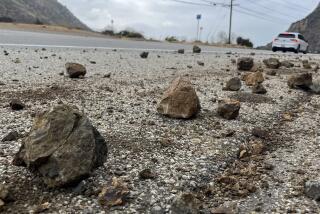Still Shocked by What Comes After
- Share via
Residents of Southern California are more earthquake-savvy than people who live anywhere else in the United States; we’ve had to be. We also have an impressive depth of earth science expertise among local media professionals, print and broadcast journalists alike. Yet one aspect of earthquake sequences seems to retain its capacity to surprise us: the late, large aftershocks that can occur months or even years after a significant earthquake. Last weekend’s temblors were the latest example of this phenomenon, coming on the heels of a late, large aftershock of the 1992 Landers earthquake that struck near Barstow on March 18. How can these be aftershocks when the mainshocks occurred three and five years ago?
The good news is that, compared to other earthquakes, aftershocks are usually well-behaved. They are defined to be events that occur within close proximity to the mainshock. Events are classified as aftershocks as long as it takes for the regional seismicity to return to the pre-mainshock levels.
These definitions will obviously blur around the edges; the late April Northridge events were somewhat larger and later than expectations, based on average statistical models. If is fair to say that they were not expected, but that is the nature of probabilities and random processes: Sometimes you flip a coin five times and get five heads.
The bad news is that, by all criteria used, an individual aftershock does not differ from an individual earthquake; the rupture processes and the ground motions are indistinguishable. As residents of the Newhall region discovered, a Magnitude 5 aftershock can wreak havoc in a grocery store as well as any other M5 event. The oft-heard phrase, “just an aftershock” carries a connotation that aftershocks are less worrisome than other earthquakes. But that is not necessarily so.
Within aftershock sequences, it is clear that subsequences occur all the time. Aftershocks can have their own aftershocks, and some of them are also foreshocks to bigger events that follow (that is, bigger than the aftershock, although not the initial mainshock).
The complexity in aftershock sequences arises largely from the three-dimensional complexity of fault systems. Some aftershocks do occur on the same segment of fault that generated the mainshock, but typically, a large number of nearby related faults will generate substantial aftershock activity. Angelenos may remember the 6.5 Big Bear aftershock to the 1992 Landers earthquake (a 7.3). Big Bear is considered an aftershock, but occurred in a region and on faults not even connected to those that produced the mainshock.
But can a so-called aftershock be a foreshock to a quake even bigger than the mainshock? If the question pointedly includes the word “can,” then the answer is yes. For example, the April 1992 6.1 Joshua Tree earthquake generated its own aftershock sequence, including events to the north, where the Landers earthquake struck in June 1992. But the question we really want answered replaces “can” with “will,” and this one we can’t answer. No earth scientist would be shocked if another Northridge-type earthquake occurred toward Simi Valley tomorrow; neither would we be shocked if nothing else big happens for another 50 years. The best answer we have comes back to statistics of observed earthquake sequences. If you want numbers, one in 20 is our best assessment of the odds that any earthquake, aftershock or not, will be followed by something bigger than itself. Two points to note: One in 20 is not zero, and in the aftermath of an M5 earthquake (or two), the odds of an M6 or greater quake have to be considered higher. But neither can one in 20 be considered bad betting odds: Facing that chance of rain, you probably would not choose to lug an umbrella around all day.
Since with earthquakes, somewhat more is at stake than getting wet, the best advice an earth science professional can give you is to use these early morning wake-up calls as just that. Go do all the things that you know you should, but maybe haven’t, to make sure that you and your loved ones are prepared the next time five heads in a row come up.
More to Read
Sign up for Essential California
The most important California stories and recommendations in your inbox every morning.
You may occasionally receive promotional content from the Los Angeles Times.










